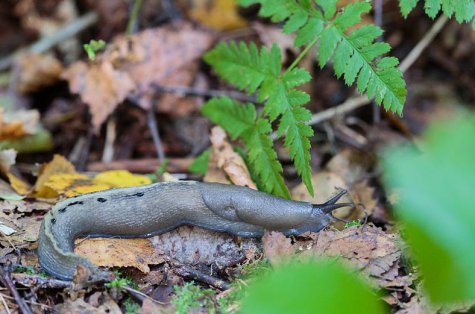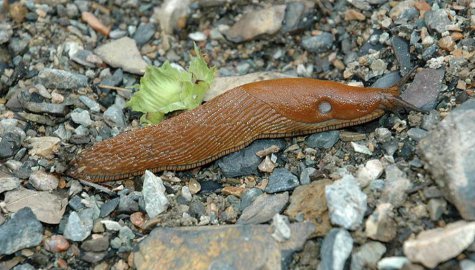Black keelback slug is no pest
Photo Arne Ader
Translation Liis
Black keelback slug
Black keelback slug Must seatigu Limax cinereoniger
Black keelback slugs are no garden vandals but completely harmless creatures whose habitats are broadleaf and mixed forests and parks. They prefer moving around at night when there is more moisture; days with rain are of course exceptions.
This summer has been favourable for the development of slugs and snails. In home gardens the pest species of course cause damage.
The black keel backs are the biggest slugs in Europe, maybe even in the world (many interesting spots in the world are still not thoroughly explored); according to literature their length can be up to 30 centimetres but such big ones I have not encountered myself.
They will not crawl into sunny spots: it might kill them, when the transparent layer of slime dries. To the lawn of a house in forest surroundings they come now simply for mushrooms, particularly if weeping boletes (Suillus granulatus) grow there. Otherwise they feed on withering leaves and all kinds of ground level algae, and they will not refuse carrion or, as said, delicious mushrooms. The evening meal of a large black keelback slug can be quite imposing – half a smallish mushroom, and only fresh ones will do.
The size of the black keelback slug has already been noted. As for colour, it may vary from brown to jet black. A lighter ridge runs along the centre of the back and on the sides darker bands and patches may be visible (but jet black is jet black). The breathing openings are at the rear end of the mantle shield. In Arne’s photo we see a mature black keel back slug.
Black keelback slugs mate on tree trunks in early summer, and both partners distribute about 400 to 800 fertilized eggs on the moss carpet. This occurs from July to early October, always in small batches at a time. Scientists maintain that it is one of the few slug species who, on lacking a mate, can fertilize its own eggs.
The „baby slugs” hatch in the moss in a couple of weeks, and get the adult colouring in a couple of months. They are not sexually mature until after 1½ - 2 years, and their average life span is about 3 years.
The garden pest, the Spanish slug (Arion vulgaris) belongs to the genus Arion. Its length is between 7 to 15 centimetres. Colour may vary widely, from dark brown, reddish, orange, yellowish to beige. Note that the slime (mucus) covering the slug is yellow. This alien species must be eradicated, nothing else to be done about it.
Image from Wikipedia










